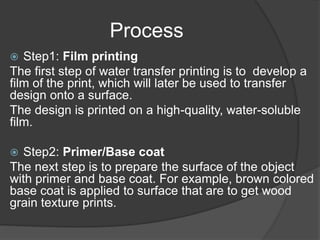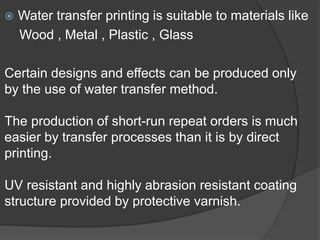Water transfer printing...
- 2. What is water transfer printing ?  Water Transfer Printing - or – Hydrographics (also known as) Hydro dipping Hydro imaging, Fluid imaging, Hydrograghic printing Is a 3D decorating process. Graphics such as carbon fibre, woodgrain, camouflage, geometrical patterns are applied to decorate the items.
- 3. Where it is used? ď‚ž The Hydro graphics process is used worldwide to decorate a variety of items,from aeroplane interiors to very small items like cell phone cases. ď‚ž Films can be applied to all kind of materials including plastic, wood, fibreglass, metal, and ceramics. ď‚ž For the most part, if the item can be dipped in water, the water transfer printing process can be applied.
- 4. Process ď‚ž Step1: Film printing The first step of water transfer printing is to develop a film of the print, which will later be used to transfer design onto a surface. The design is printed on a high-quality, water-soluble film. ď‚ž Step2: Primer/Base coat The next step is to prepare the surface of the object with primer and base coat. For example, brown colored base coat is applied to surface that are to get wood grain texture prints.
- 5. Step3: Activation the film is spread evenly onto the water using the automatic unrolling unit. It is then activated by spraying activator (HGA-EM014). During this process, the pattern is transferred onto the surface of the water. The film, once dissolved, leaves the liquefied pattern floating on the surface of the water
- 6. ď‚ž Step4: Ink transfer The next step is to transfer the print in the water to the surface of the product. For this, the products are dipped into the water. The layer of the ink wraps around the product by the natural force of water. ď‚ž Step5: Clear coating The print on the surface of a product is made durable by clear coating. After the printed surface is dried, a coat of clear coat is applied on it to protect the print.
- 7. ď‚ž Water transfer printing is suitable to materials like Wood , Metal , Plastic , Glass Certain designs and effects can be produced only by the use of water transfer method. The production of short-run repeat orders is much easier by transfer processes than it is by direct printing. UV resistant and highly abrasion resistant coating structure provided by protective varnish.









